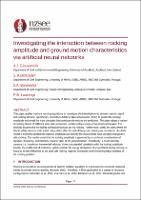| dc.description.abstract | Unreinforced masonry structures are particularly vulnerable to out-of-plane seismic loading. During an earthquake, masonry walls behave as rigid bodies undergoing rocking motion. Thus, from a dynamics perspective, their motion can be represented by the motion of a rocking block. Despite its structural simplicity, a rocking block is characterised by nonsmooth phenomena, which can cause unpredictable and often chaotic seismic behaviour. In addition, the inherent sensitivity of its response to various characteristics of the seismic signal makes the rocking problem even more complicated. Machine learning is currently utilised to investigate the underlying nonlinear interaction between structural demand and ground excitation. Specifically, artificial neural networks (ANN) are computing algorithms whose structure is inspired by the human brain. ANN have shown excellent capabilities in predicting seismic demand without the need for using complex mathematical models. Therefore, this study adopts ANN first to predict rocking amplitude and then reveal the ground motion characteristics that govern rocking response. This work reveals novel, for the rocking literature, ground motion parameters in the form of intensity measures, which show a remarkable correlation with rocking amplitude. In addition, this study combines the most influential ground motion characteristics and proposes ready-to-use seismic demand models to facilitate a rapid estimation of rocking response without the need for time-consuming nonlinear dynamic analyses. The proposed demand models show adequate prediction accuracy if one considers the expected scatter of rocking response under random recorded earthquakes. | |

